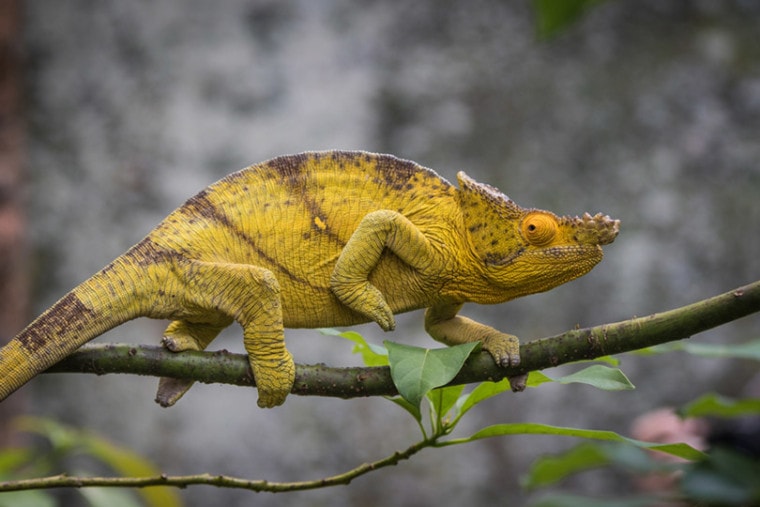
Click to Skip Ahead
Bringing home a chameleon requires a significant amount of research and preparation. One of the things that is important to know is the average lifespan of a chameleon. There isn’t a straight answer to that question, though, as it largely varies by species. Averages for longevity are based on how long the majority of something has lived. Sometimes, these averages will reflect ideal care, but more often than not, they simply reflect average care. Nothing too special, but nothing neglectful either. Suffice to say that the average lifespan of a chameleon may not be the experience that you have, but it is a good starting point.
 How Long Do Chameleons Live in the Wild?
How Long Do Chameleons Live in the Wild?
The average lifespan for wild chameleons has a lot of variability based on the species, just like with captive chameleons. Wild animals are at a greatly increased risk of predation, disease, and starvation when compared to their captive counterparts. These factors all play into a reduced life expectancy than that of captive animals. Some species of wild chameleons only have a life expectancy of 2 – 3 years, while some can live upwards of 12 – 20 years. It’s just much riskier for animals to live their lives in nature than in a safe enclosure with plenty of food.

Average Lifespans of Different Chameleon Species
| Veiled | 5 – 8 years |
| Panther | 5 – 7 years |
| Meller’s | 10 – 12 years |
| Jackson’s | 8 – 10 years |
| Four-Horned | 3 – 7 years |
| Carpet | 2 – 3 years |
| Fischer’s | 3 – 5 years |
| Senegal | 2 – 5 years |
| Flap-Necked | 5 – 8 years |
| Usambara Pitted Pygmy | 1 – 3 years |
| Parson’s | 8 – 12 years |
| Cuban False | 3 – 10 years |
| Pygmy | 1 – 3 years |
| Bearded Pygmy | 1 – 3 years |
Why Do Some Chameleons Live Longer Than Others?
1. Diet
Chameleons are omnivores by nature, with the majority of their diet consisting of insects. In captivity, chameleons should be fed a varied diet of insects consisting of gut-loaded crickets, grasshoppers, hornworms, and dubia roaches, with insects like waxworms, mealworms, and superworms fed sparingly as treats. Gut-loading makes the insects more nutritious for your chameleon, ensuring all dietary needs are met. They should also be offered dark leafy greens, like mustard greens, collard greens, dandelion greens, endive, escarole, kale, and romaine lettuce, and other veggies, like sweet potato, summer squash, winter squash, carrots, and bell peppers. Some chameleons will refuse to eat veggies entirely, while others will pick and choose their favorites. The most important thing is ensuring the diet you’re providing is nutritionally sound and nutrient dense. Supplements should be provided in the form of calcium dust with and without vitamin D3 and reptile vitamins.
2. Enclosure
Most chameleons do best when kept in tall enclosures with plenty of airflow, and some people even recommend using screened enclosures versus glass or acrylic. They need a humid environment, which can be achieved with a spray bottle, mister, or dripper. The need for humidity makes adequate airflow extremely important to prevent the growth of bacteria, fungus, and mold. All of these things are capable of making your chameleon very sick. As arboreal animals, they prefer to be high up, so a network of branches and plants for climbing and exploring is necessary to ensuring your chameleon’s stress level stays down. Keep the ambient temperature of the enclosure in the 72 – 80°F range, with 70°F being the absolute minimum. A basking area that stays in the 85 – 95°F range should also be provided. UVB lighting is necessary to ensuring your chameleon properly synthesizes vitamin D3.
3. Safety
A safe and secure environment for your chameleon will improve the chances of a long life. The enclosure should have no weak points that may give your chameleon an escape route or allow other pets to access the enclosure. Everything in the enclosure should be installed securely and made to be safe for chameleons. Live plants should be chameleon-friendly, like pothos and hibiscus plants. Also, consider the safety of any other spaces in your home that your chameleon may be allowed to go. Some chameleons enjoy time outside of their enclosure. However, they should not be allowed around other pets or small children if not supervised by an adult. They shouldn’t be allowed to freely wander without proper supervision, and everything they may encounter should be safe for them, including plants and climbing surfaces.
4. Medical Care
Access to medical care is a major advantage that pet chameleons have over wild chameleons. Find an exotics vet near you who knows proper reptile husbandry. While chameleons may not require regular vet visits like cats and dogs, they should still be checked over by a vet from time to time. A vet will be able to identify problems you may not be aware of, as well as being a great resource for chameleon husbandry help and tips.
 In Conclusion
In Conclusion
Chameleons aren’t the most long-lived pet you can have, but many of them can leave very long, full lives with proper care. Lifespan averages don’t always reflect the amount of time that your chameleon will actually be with you. After all, the average lifespan of a goldfish is around 10 – 15 years, but the longest-lived goldfish lived to 42 years old. With excellent care, your chameleon may surprise you. To give your chameleon the best shot at a long life, never be afraid to ask questions or seek assistance with any questions or concerns you may have about your chameleon.
Featured Image Credit: Virginie Merckaert, Shutterstock
 How Long Do Chameleons Live in the Wild?
How Long Do Chameleons Live in the Wild?





